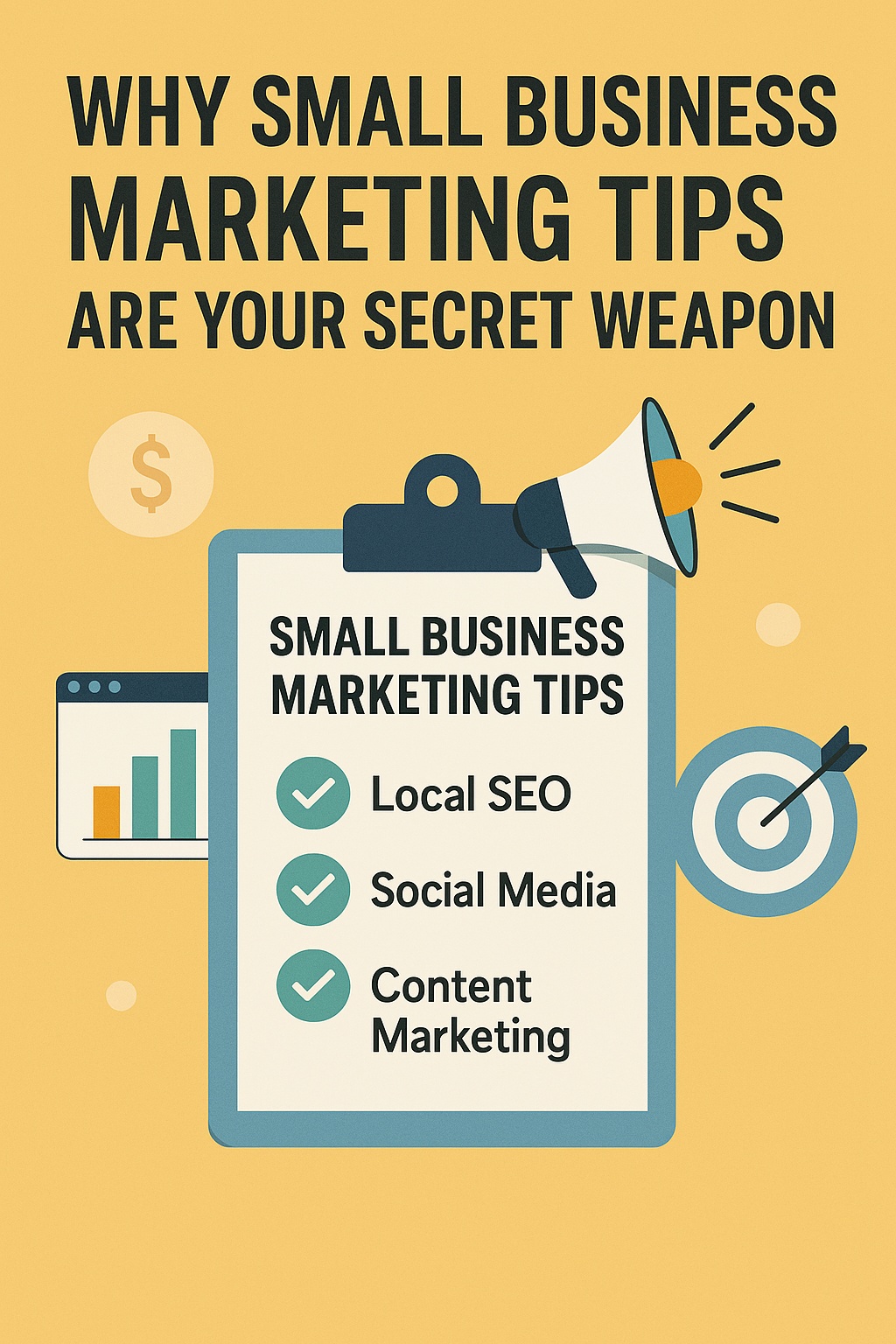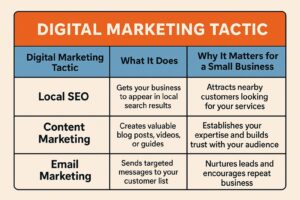Do you own a small business? Marketing can feel like a huge challenge. You have a great product or service. But how do you get the word out? The truth is, you don’t need a giant budget to succeed. You just need the right small business marketing tips. These strategies help you connect with people. They build your brand. And they bring in new customers. It’s about being smart, not just spending a lot of money.
This guide shares simple, powerful ways to market your business. We’ll cover everything from online basics to clever content ideas. You’ll learn how to reach your ideal customer. We’ll look at what works today. Ready to start attracting more business? Let’s dive in.
Getting Started with Digital Marketing
So, what’s the first step? Start online. This is where most of your customers are. Digital marketing for small business isn’t scary. It’s a set of tools you can use. Think of your website as your home base. It needs to look good and be easy to use. People will visit it to learn about your company. Make sure it tells your story clearly. You also need to show up in search results. This is where SEO comes in. SEO stands for Search Engine Optimization. It helps your website rank higher on Google.
Consider this: people search for local services every day. You want to be at the top of that list. A good SEO strategy can get you there. It’s about using the right words. It’s also about having a fast, secure website. A strong online presence is a game-changer for any small company. It builds trust and credibility. It shows you’re serious about what you do.
Building Your Website Foundation
Your website is your online business card. It needs to be easy to navigate. Visitors should find what they need in seconds. Make sure your contact information is easy to find. Use clear headings and short paragraphs. A well-designed website makes a great first impression. It tells visitors you are professional and trustworthy.
| Digital Marketing Tactic | What It Does | Why It Matters for a Small Business |
|---|---|---|
| Local SEO | Gets your business to appear in local search results. | Attracts nearby customers looking for your services. |
| Content Marketing | Creates valuable blog posts, videos, or guides. | Establishes your expertise and builds trust with your audience. |
| Email Marketing | Sends targeted messages to your customer list. | Nurtures leads and encourages repeat business. |
| Social Media | Connects you with customers on platforms like Instagram or Facebook. | Builds a community and humanizes your brand. |
Building Your Social Media Presence
Social media is a powerful tool. Social media marketing for small business allows you to talk directly to your customers. You can share updates, post photos, and answer questions. It’s like having a digital storefront that’s always open. But don’t try to be on every platform at once. Pick one or two that make the most sense for your business. Are you a bakery? Instagram is a perfect fit. Do you offer B2B services? LinkedIn is probably a better bet.
Once you pick a platform, be consistent. Post regularly. Respond to comments and messages. Show some personality. Your social media feed should feel friendly and real. Titonian Wallace Sr. says, “Social media is less about selling and more about building relationships. Show your passion, and people will notice.” People buy from people they like. Your social media presence is the best way to let your personality shine through. It’s your chance to build a real community.
Choosing the Right Social Media Platform
Selecting the right platform is key to success. A restaurant should use Instagram to show off food. A consultant might use LinkedIn to share professional insights. Think about where your ideal customer spends their time online. A quick search can tell you a lot about your audience’s habits. By focusing your efforts, you can get better results. It saves you time and energy, too.
The Power of Content Marketing
Want to be seen as an expert? Start creating content. Content marketing for small business involves making valuable articles, videos, or guides. Instead of just selling your product, you’re helping people. A plumber could write a blog post about “5 Ways to Prevent Clogged Drains.” An accountant might create a video on “Tax Tips for Freelancers.” This builds trust. People see you as a source of useful information. When they need your services, you’ll be the first person they think of.
Content marketing is a long-term strategy. It takes time to see results. But those results are worth it. High-quality content improves your SEO. It gives you things to share on social media. It even provides topics for your email newsletter. According to a study by the Content Marketing Institute, 60% of marketers create at least one piece of content per day. This shows just how important it is. It helps your business stand out in a crowded market.
Generating Content Ideas
Finding new things to write about can be hard. The best ideas often come from your customers. What questions do they ask you the most? What problems do they need help with? You can create content that answers these questions. You can also look at what your competitors are doing. What topics are popular in your industry? Answering these questions can give you a strong starting point.
Local SEO: Your Key to Neighborhood Success
Are most of your customers in your local area? Then you need to focus on local SEO for small business. This is different from regular SEO. Local SEO helps you show up when people in your neighborhood search for things. For example, when someone searches “coffee shop near me,” you want your business to be the first one they see.
Here’s how to do it:
- Google Business Profile: This is a free tool from Google. Fill out your profile completely. Add your address, hours, photos, and a description. Make sure the information is accurate.
- Customer Reviews: Encourage happy customers to leave reviews on Google, Yelp, or other sites. Respond to all reviews, good and bad. This shows you care about your customers.
- Consistent Information: Make sure your business name, address, and phone number are the same everywhere online. This consistency builds trust with search engines.
Local SEO is a straightforward way to attract nearby customers. It targets people who are ready to buy. The best part? It’s often free or very low-cost. For more info, check out this post: Local SEO Tips.
Building a Strong Email Marketing List
Think email is old school? Think again. Email marketing for small business is still one of the most effective ways to connect with your audience. An email list is a direct line to your customers. You own this list. You don’t have to worry about algorithm changes like you do on social media.
Start by offering something valuable in exchange for an email address. Maybe it’s a free guide, a coupon, or access to exclusive content. Once you have their email, send them useful, engaging messages. Don’t just spam them with sales pitches. Share new blog posts. Announce special offers. Tell them a story about your business. A personal email feels much more special than a social media post. It helps you build a strong, loyal relationship with your customers. It’s a key part of any solid marketing plan.
Here is a graph showing the effectiveness of email marketing.
This graph illustrates that for every dollar spent, email marketing can generate a significant return, often outperforming other digital marketing channels. It’s a low-cost, high-return strategy.
Growing Your Email List
How do you get more people to sign up? Place a sign-up form on your website. Make it easy to find. Offer a clear reason for people to join. Tell them what they’ll get. A simple “Join our newsletter for exclusive tips” can work wonders. You can also promote your list on social media. Run a contest or a giveaway to get people to sign up.
Simple Marketing Strategies That Don’t Cost a Fortune
So many small business marketing tips don’t require a huge budget. What are some of those ideas? Start with networking. Go to local events. Meet other business owners. You can form partnerships. Maybe you can promote each other’s services. Consider a loyalty program. Offer a punch card or a discount for repeat customers. It’s much easier to keep a customer than to find a new one.
Another idea is to leverage your current customers. Ask them for testimonials or case studies. Share their stories on your website or social media. People trust recommendations from real people. According to a Nielsen study, 92% of consumers trust earned media, such as word-of-mouth and recommendations from friends and family, over all other forms of advertising. That’s a powerful statistic.
You can also try a referral program. Give a discount to both the new customer and the person who referred them. It’s a win-win situation. For more smart ideas, check out this article on brand building: Smart Branding Tips.
Partnering with Other Businesses
Working with other local businesses can be a smart move. A bakery could partner with a coffee shop. A gym could team up with a health food store. You can cross-promote each other’s products. You can also run joint promotions or events. This expands your reach to a new audience. It builds strong community ties, too.
Measuring Your Marketing Success
How do you know if your marketing is working? You have to track your efforts. It’s so important. Look at your website traffic. Are more people visiting your site? Are they staying for a longer time? Use tools like Google Analytics to see what people are doing on your site.
You can also track your social media engagement. Are people liking, sharing, and commenting on your posts? Look at your sales data too. Did a new marketing campaign bring in more sales? Don’t forget to ask new customers how they found you. This simple question gives you great insights. Maybe they saw you on Facebook or got a recommendation from a friend. Understanding what works helps you focus your time and money on the most effective strategies. For more info, see this post: Boost Your ROI.
Here is a table to help you keep track of your marketing efforts.
| Marketing Channel | What to Track | Tool or Method |
|---|---|---|
| Website | Traffic, Bounce Rate, Conversions | Google Analytics |
| Social Media | Likes, Shares, Comments, Clicks | Platform Insights (e.g., Facebook Insights) |
| Email Marketing | Open Rate, Click-Through Rate, Unsubscribes | Email Service Provider Reports |
| Local SEO | Calls from Search, Directions Requests | Google Business Profile Insights |
| Content Marketing | Page Views, Time on Page, Shares | Google Analytics |
Key Takeaways
- Focus on digital marketing for small business to reach a wider audience.
- Use social media marketing for small business to build a community and connect with customers.
- Invest in content marketing for small business to establish expertise and build trust.
- Prioritize local SEO for small business to attract nearby customers and get found online.
- Leverage email marketing for small business for a direct, reliable communication channel.
- Measure your results to see what’s working and adjust your strategy.
- Remember that good marketing is about building relationships, not just making sales.
Frequently Asked Questions
Q: How much should a small business budget for marketing?
A: There’s no one-size-fits-all answer. Many experts suggest setting aside 7-8% of your gross revenue for marketing. If you’re a new business, you might spend more in the beginning to build your brand.
Q: What is the most important marketing tip for a brand new business?
A: The most important thing is to understand your target audience. Who are you trying to reach? What are their needs and problems? Once you know that, all your marketing efforts will be more effective.
Q: Can I do all my marketing myself?
A: Yes, you can. Many of these strategies are simple to start. You can do a lot on your own. As your business grows, you might consider hiring a professional or a team to help you manage things.
Q: How do I know if my marketing is working?
A: You need to set clear goals and track your progress. Are you getting more website visitors? More calls? More sales? Use tools and data to measure your results and make informed decisions.
Conclusion: Your Path to Growth
Marketing for a small business doesn’t have to be overwhelming. By following these small business marketing tips, you can create a strategy that fits your budget and helps you grow. Start with one or two ideas. Get good at them. Then, add more as you go. The goal is to build a consistent presence. Show your customers who you are. Provide value. Be helpful.
Your business has something special to offer. Marketing is how you tell that story to the world. Don’t be afraid to experiment. See what works. Remember, every big company started small. Use these tips to build your foundation for success.
Ready to take your marketing to the next level? Contact us today to see how Nesace Media can help. Contact us




